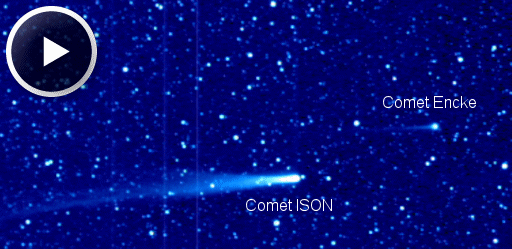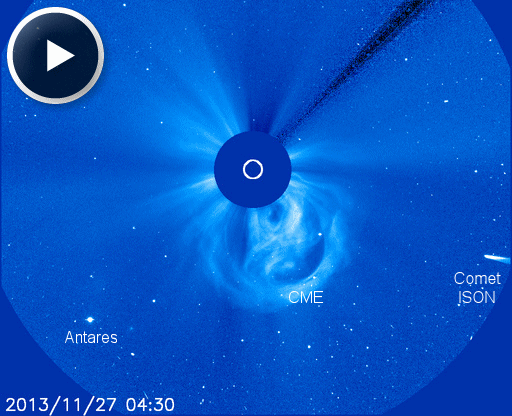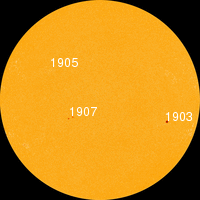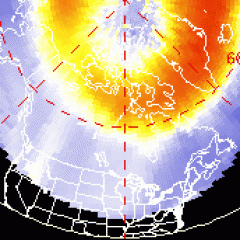SLIGHT CHANCE OF FLARES: The Earthside of the sun is quiet. NOAA forecasters estimate a slim 1% chance of either M- or X-class solar flares on Nov. 27th. However, there is at least one active region on the farside of the sun which could target Comet ISON when it swings around the farside after Nov. 28th. Solar flare alerts: text, voice
COMET ISON, SO FAR SO GOOD: Comet ISON is hurtling toward the sun today at 240,000 mph and, despite the rising heat, the comet appears to be intact. Yesterday, reports of fading spectral lines from the comet's core raised concerns that the icy nucleus might be disintegrating. Current images from NASA and ESA spacecraft, however, show the comet still going strong. Comet ISON has just entered the field of view of the Solar and Heliospheric Observatory (SOHO):
The comet's entrance coincides with a bright CME racing away from the sun's southwestern limb. Astronomers have been wondering what might happen if a CME strikes Comet ISON. This CME, however, will probably miss. The source of the cloud is a farside active region, which is not directly facing the comet.
NASA's STEREO-A spacecraft is also monitoring the comet. Click to view a high-resolution movie (32 MB), which compresses 96 hours into less than 1 minute:

Credits: This movie was made by reader Rob Matson using data from STEREO-A.
The movie spans a 3+ day interval from Nov. 21 to Nov. 24 roughly centered on the period when astronomers at the IRAM telescope in Spain recorded fading emission lines from the comet's core. Zoom your movie-player to full screen: Although "puffs" of material can be seen billowing down the comet's tail, the comet itself does not appear to be disintegrating. So what caused the fade...?
"I will admit that I was pretty worried yesterday morning when reports of lower production rates came in," says Matthew Knight of the Lowell Observatory and NASA's Comet ISON Observation Campaign. "However, the STEREO-A brightness has increased steadily over the subsequent 36 hr, and I'm more optimistic again. My off-the-cuff thought is that there was an [outburst of dust, which dampened the emission lines] from roughly Nov 20-22, and it has returned to brightening again."
Astronomer Karl Battams of NASA's Comet ISON Observing Campaign urges readers to remember the following: "Comet ISON is a dynamically new sungrazing comet, fresh in from the Oort Cloud, and the last time we saw an object like this was never! Furthermore, a sungrazing comet just days from perihelion has never been studied in this kind of detail - we're breaking new ground! When we factor in your standard 'comets are unpredictable' disclaimer, what we have is a huge recipe for the unknown."
Stay tuned for updates.

Solar wind
speed: 305.5 km/sec
density: 1.0 protons/cm3
explanation | more data
Updated: Today at 1557 UT
X-ray Solar Flares
6-hr max: C1 1500 UT Nov27
24-hr: C1 1500 UT Nov27
explanation | more data
Updated: Today at: 1500 UT
![]()
Daily Sun: 27 Nov 13
None of the spots on the Earthside of the sun pose a threat for flares. Solar activity is low. Credit: SDO/HMI
![]()
Sunspot number: 47
What is the sunspot number?
Updated 27 Nov 2013
Spotless Days
Current Stretch: 0 days
2013 total: 0 days (0%)
2012 total: 0 days (0%)
2011 total: 2 days (<1%)
2010 total: 51 days (14%)
2009 total: 260 days (71%)
Since 2004: 821 days
Typical Solar Min: 486 days
Update 27 Nov 2013
The Radio Sun
10.7 cm flux: 116 sfu
explanation | more data
Updated 27 Nov 2013
![]()
Current Auroral Oval:
Switch to: Europe, USA, New Zealand, Antarctica
Credit: NOAA/POES
![]()
Planetary K-index
Now: Kp= 1 quiet
24-hr max: Kp= 1 quiet
explanation | more data
Interplanetary Mag. Field
Btotal: 6.5 nT
Bz: 6.0 nT north
explanation | more data
Updated: Today at 1557 UT
![]()
Coronal Holes: 27 Nov 13
There are no large coronal holes on the Earthside of the sun. Credit: SDO/AIA.





